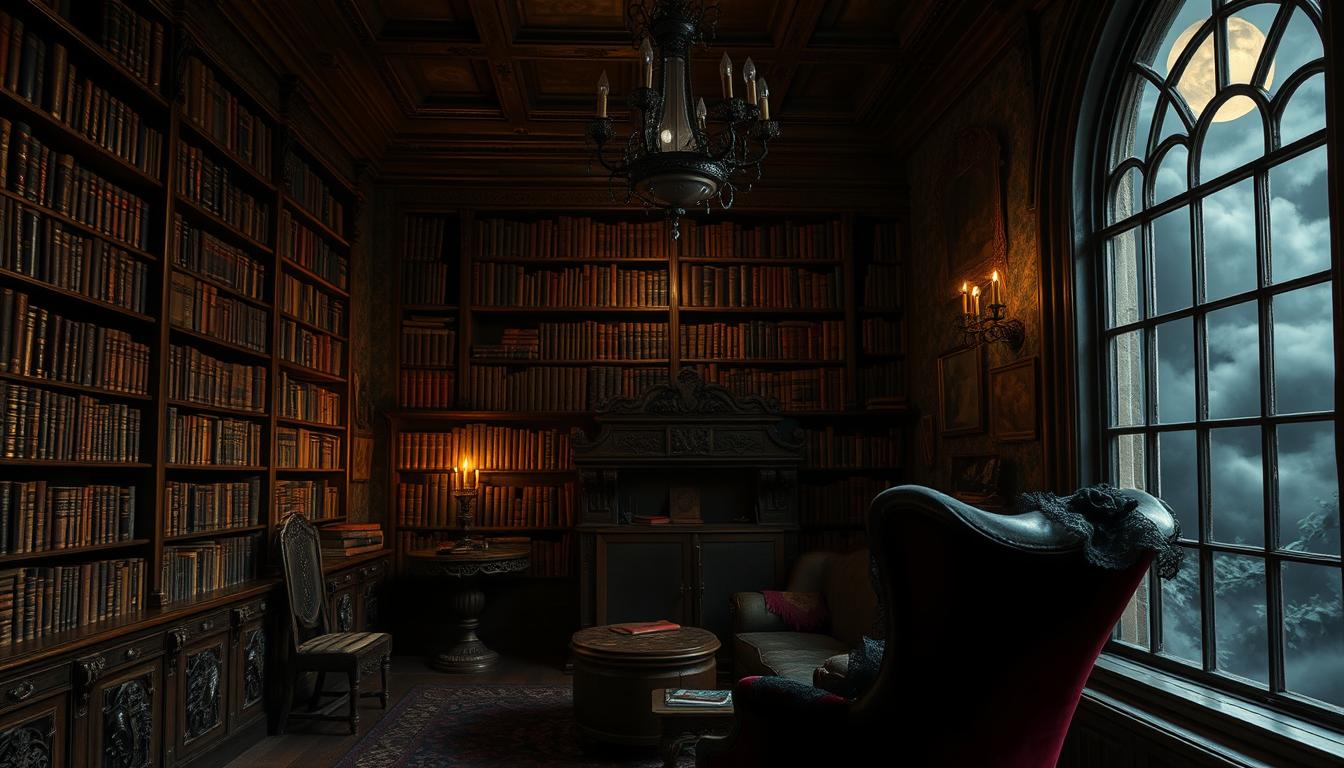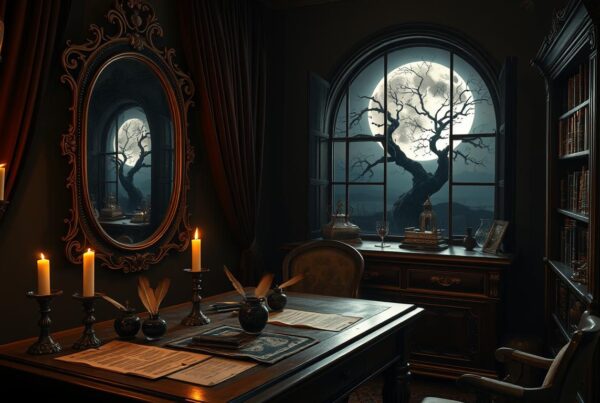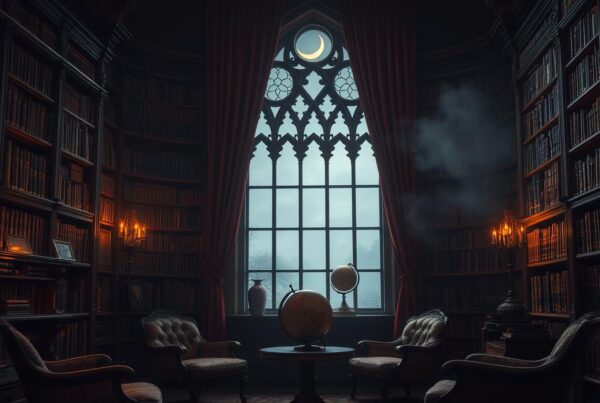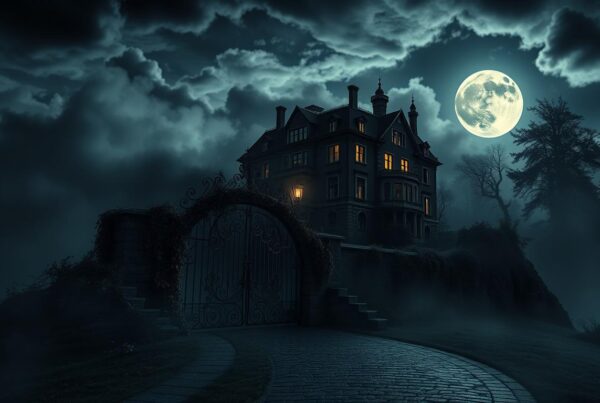Step into a world of shadowy mansions and forbidden love. Our list of the top 10 gothic romance novels is here. These classic books have captivated readers for generations. They blend dark romance with haunting tales that linger long after the last page.
From misty moors to candlelit corridors, these stories take you to atmospheric settings. Passion and mystery intertwine here. Get ready to be swept away by brooding heroes, complex heroines, and the allure of gothic literature.
Our curated selection showcases the finest romantic novels in this genre. Each is a masterpiece of suspense and desire. Get ready to explore these timeless works that have shaped dark romance for centuries.
The Allure of Gothic Romance: A Timeless Genre
Gothic romance novels are loved for mixing love and fear. They take us to dark, mysterious places. Here, passion and danger meet.
Defining Gothic Romance
Gothic romance is a mix of horror and romance. It has brooding heroes and innocent heroines. The stories often take place in eerie settings.
They explore forbidden love and dark secrets. This makes the genre very interesting.
Historical Context and Evolution
The genre started in the late 18th century with “The Castle of Otranto” by Horace Walpole. It became more popular in the 19th century. Today, it still influences literature.
Gothic romance has changed over time. But its core elements are still loved by many.
Key Elements of Gothic Romance Novels
Gothic tropes are key to the genre. These include haunted castles and family curses. Supernatural beings also play a big role.
The dark atmosphere makes us feel something is coming. Romantic suspense keeps us guessing. Supernatural elements add mystery. Together, they create unforgettable stories of love and fear.
Wuthering Heights by Emily Brontë: A Haunting Classic
Emily Brontë’s masterpiece, Wuthering Heights, is a top gothic romance. It’s set in the wild Yorkshire moors. The story is about passionate love and bitter revenge, loved by many for years.
Heathcliff and Catherine are at the heart of the story. They are two of the most complex characters in literature. Their love story is wild and goes beyond death. Brontë’s words make the moors come alive, matching the characters’ strong feelings.
The book talks about love that destroys and the harm of revenge. Heathcliff changes from a quiet orphan to a man full of anger. His love for Catherine is like “the eternal rocks beneath,” the heart of the story.
Wuthering Heights still touches readers today. Its themes of all-consuming love and fighting against what society wants are still important. This classic is a true gothic romance, mixing dark love with the wild moors.
Jane Eyre by Charlotte Brontë: Love and Mystery on the Moors
Charlotte Brontë’s “Jane Eyre” is a key part of Victorian literature. It tells the story of a young governess’s journey. She finds love and discovers herself in this tale.
The Enigmatic Mr. Rochester
Mr. Rochester is at the center of this story. His dark past and complex personality are mysterious. They draw Jane in, making their relationship special.
They meet at Thornfield Hall, a grand estate with secrets. This adds to the mystery of their love.
Gothic Elements in Thornfield Hall
Thornfield Hall is full of gothic atmosphere. Its dark corridors and hidden rooms show the characters’ deep thoughts. Strange sounds and unexplained events add suspense.
Themes of Independence and Passion
Jane Eyre talks about feminism in a way that was new back then. Jane wants to be free and equal. Her passion and duty create a deep inner struggle.
Brontë’s work still draws people in today. It has great characters, a setting that pulls you in, and themes that are still relevant. It’s a classic example of gothic romance in Victorian literature.
Rebecca by Daphne du Maurier: Shadows of the Past

Daphne du Maurier’s “Rebecca” is a gothic romance masterpiece. It tells the story of a young woman who marries Maxim de Winter. Their life at Manderley, a grand estate, turns into a thrilling psychological journey.
The protagonist is haunted by Rebecca, Maxim’s first wife. Mrs. Danvers, the housekeeper, adds to the eerie feel. Her love for Rebecca makes everyone feel uneasy.
Manderley is more than a house; it’s a character with secrets. Du Maurier’s vivid descriptions pull readers into a world of mystery. The tension she creates keeps readers guessing.
As the story goes on, the past and present mix. The narrator’s doubts and Rebecca’s ghost make the story intense. This mix of romance and drama has made “Rebecca” a classic loved by many.
Dracula by Bram Stoker: Vampiric Passion and Terror
Bram Stoker’s “Dracula” is a key part of vampire stories. It mixes horror with forbidden love. The book tells its story through letters, diary entries, and newspaper articles.
The Seductive Count Dracula
Count Dracula represents Victorian fears of the unknown and exotic allure. His character stirs deep fears about sex and moral decay. He is both scary and intriguing.
Gothic Atmosphere of Transylvania
Stoker makes Transylvania seem like a place stuck in time. Here, old myths meet modern ways. The misty Carpathian Mountains and Dracula’s old castle are perfect for spooky stories.
Love, Fear, and Redemption
“Dracula” is about the fight between good and evil, love and fear. The characters face the vampire count to save their souls. This story has shaped our view of vampires and gothic love.
The Phantom of the Opera by Gaston Leroux: Tragic Love in the Paris Opera
Gaston Leroux’s “The Phantom of the Opera” is a haunting tale of love and mystery. It’s set in the famous Opéra Garnier. The story follows a masked villain who loves the beautiful soprano, Christine Daaé, but she doesn’t love him back.
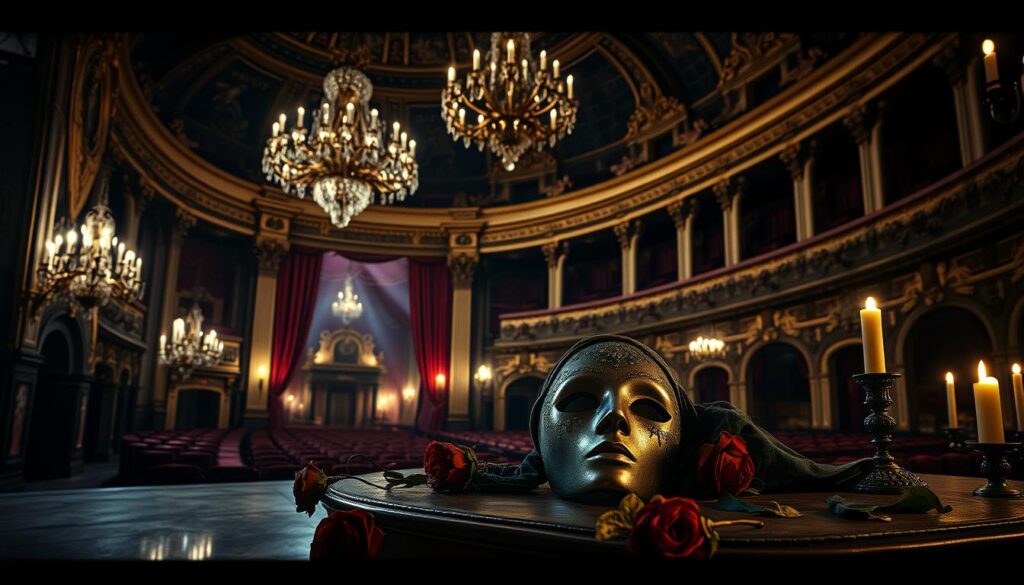
The Opéra Garnier is the perfect setting for this chilling romance. Its grand architecture and hidden passages create a mix of wonder and fear. Leroux’s words make the opera house come alive, turning it into a character itself.
The Phantom is a tragic figure who lives in the opera house’s shadows. His love for Christine drives the story, leading to dramatic events. These events mix romance, horror, and music in a unique way.
The novel has become very popular, thanks to Andrew Lloyd Webber’s musical adaptation. This version has brought the Phantom’s story to more people. It has made the Phantom’s tragic love story famous around the world.
Northanger Abbey by Jane Austen: A Satirical Take on Gothic Romance
Jane Austen’s “Northanger Abbey” is a clever satire of the Gothic genre. It’s a Regency romance about Catherine Morland, a young woman. She loves Gothic novels and sees the world through their lens.
Catherine Morland’s Vivid Imagination
Catherine’s journey from a naive reader to a wise adult is the novel’s core. Her vivid imagination, fueled by Gothic tales, makes her see dangers everywhere.
Parody of Gothic Tropes
Austen cleverly mocks Gothic elements in the novel. She pokes fun at gloomy castles, family secrets, and brooding heroes. This shows how silly these elements are in real life.
Romance and Reality Collide
Catherine faces her first social season in Bath, learning to tell fiction from reality. Her growing bond with Henry Tilney contrasts with her Gothic dreams. It brings her back to the real world of Regency society.
“Northanger Abbey” is a witty look at literature and society, wrapped in a charming love story. This mix of satire and romance still draws readers in. It makes the novel a classic in the Gothic-inspired genre.
The Picture of Dorian Gray by Oscar Wilde: Beauty, Corruption, and Desire
Oscar Wilde’s only novel, “The Picture of Dorian Gray,” is a deep dive into aestheticism and moral decay. It’s a gothic tale of a young man who trades his soul for eternal youth. This Faustian bargain leads to his downfall.
Dorian Gray’s adventures in London’s high society expose the dark side of desire and corruption. His portrait ages and becomes hideous with each bad deed. Yet, Dorian stays young and beautiful. This contrast challenges the strict morals of the time.
Wilde’s writing is like a gothic tapestry, filled with eerie portraits and foggy streets. The complex relationships between Dorian, Lord Henry, and Basil Hallward explore beauty’s power. They also show the dangers of too much hedonism.
“The Picture of Dorian Gray” still fascinates readers today. It warns us about the dangers of vanity and the risks of seeking too much pleasure. It’s a must-read for anyone who loves gothic romances.
